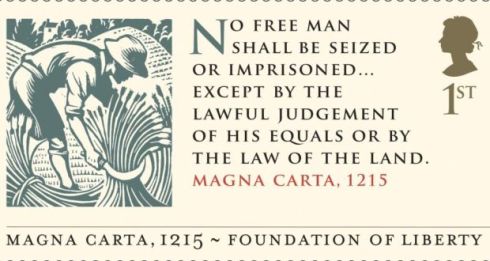As today marks the 800th anniversary of the reluctant concession to the Magna Carta by King John at Runnymeade, there clearly is no other topic on which to focus than this Charter, which has become far more momentous with history than in its own time. There is a seemingly-definitive exhibition at the British Library: “The Magna Carta: Law, Liberty, Legacy”, which is full of iconic documents, including Thomas Jefferson’s handwritten copy of the Declaration of Independence, and interesting facts: apparently the British were contemplating luring the U.S. into World War II by offering us the Lincoln Cathedral copy of the Magna Carta! Neither of these inclusions surprise me, as Americans have always viewed the Great Charter through the prism of their own constitutional struggles, rather than its more precise historical context. Invariably if I ask a student in my Medieval class what it is, they will say: “the British Constitution”. This horrifies my British friends, who maintain that they don’t need a constitution: the beauty of British history and government is the gradual, organic evolution of civil liberties and the universal understanding of just what these liberties should be, rather than their explicit expression on a piece of paper. But there have been many pieces of paper (or parchment) which have defined individual rights in relation to government, and the Magna Carta is a particularly prominent one. Its reissuing in 1216, 1217 and 1225, printing in 1534, and role as a touchstone in the constitutional struggles of the seventeenth and eighteenth centuries (and after) determined its greatness, over time and as precedent.
Cropped image of one of four 1215 Magna Cartas and the big moment portrayed in a colored print based on a 1776 painting by John Hamilton Mortimer, British Museum, from the British Library exhibition The Magna Carta: Law, Liberty, Legacy. It’s impossible to find an image of this historic signing before the early modern era, and they really proliferate in the eighteenth and nineteenth centuries. The legacy of the Magna Carta, below:
First printing by Robert Redman, 1534; inclusion as one of the “Emblems of England” during the Cromwellian Regime, 1650s; Thomas Bewick’s engraving of the feudal knight passing Magna Carta to Britannia, with Lady Liberty overlooking (very important–the feudal knight passes the torch of “liberty” to the Enlightenment!), and the contrast between liberty in Britain and France in 1792, all from the British Museum; Ladies handkerchief portraying the signing of the Magna Carta, 19th century, Victoria & Albert Museum; “Votes for Women” reference, 1911 and editorial cartoon protesting the 2005 Prevention of Terrorism Bill, ©The Times and the British Cartoon Archive at the University of Kent (“mini Carta”!!!); Royal Mail commemorative stamp, 2015.
















June 15th, 2015 at 10:43 am
I love history!
June 15th, 2015 at 12:52 pm
I remember visiting the site over 20 years ago, and discovering that the most obvious monument to the signing had been erected by the American Bar Association. Made me wonder whether Americans or the British held the document in higher esteem. After all, it was satirized in “1066 and All That.”
June 15th, 2015 at 1:26 pm
Big sponsorship on the part of both American and British law firms for this exhibition…..
June 15th, 2015 at 3:44 pm
“reluctant signing of the Magna Carta by King John I”
He sealed it actually. This doesn’t mean he was illiterate, as is sometimes claimed, any more than later men putting an X on a document were illiterate. It was the standard legal acknowledgment that he had read and accepted it. He was also the only King John – and given the ignominy he brought to the name, likely to remain the only one – so there’s no need for a number.
June 15th, 2015 at 3:47 pm
Yes, you’re right Roger–I did hesitate about adding the number!
November 21st, 2015 at 12:14 am
[…] Magna Carta Monday […]